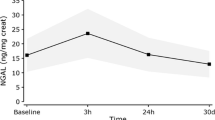Abstract
In an attempt to evaluate renal injury relative to open surgery, percutaneous nephrolithotripsy (PCN) and extracorporeal shock wave lithotripsy (ESWL) were studied in 52 patients with renal calculus disease.
Preoperative and postoperative urinary levels of N-acetyl-glycosaminidase (NAG), a sensitive marker of renal tubular damage, were studied. No significant changes were noted in posttreatment urinary NAG values among patients who underwent ESWL or PCN. Although statistically nonsignificant, a constant mild increase of urinary NAG was observed after PCN, that has to be evaluated with long-term follow-up studies. The shock wave number or power in cases treated with ESWL as well as the number of renal punctures in the PCN group did not change the effect on renal tubular function. Diabetics and patients with chronic renal disease treated by ESWL did not show any significant change in posttreatment urinary NAG levels.
In contrast to that, all patients treated by open surgery had significant, intense and prolonged increase of the postoperative NAG values, especially those treated by ischaemic nephrolithotomy.
Comparing the three different therapeutic modalities, open surgical procedures had the most significant effect on renal function and this difference was statistically significant. We therefore suggest that ESWL does not endanger renal function, while open surgery must be reserved for selected cases.
Similar content being viewed by others
References
Wichkam, J. E. A., Hanley, H. G., Joekes, A. M.: Regional renal hypothermiaBr. J. Urol., 39, 727 (1967).
Boyce, W. H., Elkins, I. B.: Reconstructive renal surgery following anatrophic nephrolithotomy. Follow up of 100 consecutive cases.J. Urol., 111, 307 (1974).
Marberger, M., Eisenberger, F.: Regional hypothermia of the kidney: Surface or transarterial perfusion cooling? A functional study,J. Urol., 124, 179 (1980).
Mayo, M. E., Krieger, J. N., Rudd, T. D.: Effect of percutaneous nephrostolithotomy on renal function.J. Urol. 133, 167 (1985).
Webb, D. R., Fitzpatrick, J. M.: Percutaneous nephrolithotripsy: A functional and morphological study.J. Urol..134, 587 (1985).
Spirnak, J. P., Resnick, M. I., Pak, C. Y.: Extracorporeal shock wave lithotripsy. In: Urolithiasis. A medical and surgical reference by Resnick, M. I. and Pak, C. Y. Ch. 17. Saunders, Philadelphia 1990, pp. 321–361.
Kaude, J. V., Williams, C. M., Millner, R. M., Scott, N. K., Finlayson, B.: Renal morphology and function immediately after extracorporeal shock wave lithotripsy.A.J.R., 145, 305 (1985).
Wilson, T. W., Preminger, G. M.: Extracorporeal shock wave lithotripsy. An update.Urol. Clin. N. Amer., 17, 231 (1990).
Gonick, G. C., Kramer, H. J., Schapiro, A. E.: Urinary b-glucuronidase activity in renal disease.Arch. Int. Med., 132, 63 (1973).
Jung, K., Schulze, B. D., Sydow, K.: Diagnostic significance of different urinary enzymes in patients suffering from chronic renal diseases.Clin. Chim. Acta, 168, 287 (1987).
Guder, N. G., Ross, B. D.: Enzyme distribution along the nephron.Kidney Int., 26, 101 (1984).
Kunin, M. C., Chesney, W. R., Craig, W. A., England, A. C., De Angelis, C.: Enzymuria as a marker of renal injury and disease. Studies of N-acetyl-b-glucosaminidase in the general population and in patients with renal diseasePediatrics, 62, 751 (1978).
Tataranni, G., Farinelli, R., Zavagli, G., Logallo, G., Farinelli, A.: Tubule recovery after nephropathy relief. The value of enzymuria and microproteinuria.J. Urol., 138, 24 (1987).
Bourbouze, R., Gluckman, J. C., Frantz, P., Paraire, M., Baumann, F. C., Luciani, J., Percheron, F., Legrain, M.: Early monitoring of human renal transplantations by NAG isoenzyme activities in urines.Clin. Chim. Acta, 149, 185 (1985).
Damiani, E., Cattaneo, M. T., Sessa, C., Zucca, E., Cavalli, F., Bertolini, A., Libretti, A., Beretta, R.: Enzymuria in carboplatin nephrotoxicity.Tumori, 73, 487 (1987).
Price, R. G., Dance, N., Richards, B., Cattall, W. R.: The excretion of N-acetyl-b-galactosidase following surgery to the kidney.Clin. Chim. Acta, 27, 65 (1970).
Trinchieri, A., Mandressi, G., Zanetti, G., Ruoppolo, M., Tombolini, P., Pisani, E.: Renal tubular damage after renal stone treatment.Urol. Res., 16, 101 (1988).
Fitzpatrick, J. M., Sleight, M. W., Braack, A., Marberger, M., Wickham, J. F. A.: Intrarenal access: Effects on renal function and morphology.Br. J. Urol., 52, 409 (1980).
Ekelund, L., Lindsted, E., Lundquist, B. S., Sundin, T., White, T.: Studies on renal damage from percutaneous nephrolitholapaxy.J. Urol., 135, 682 (1986).
Kurth, K. H., Hohenfellner, R., Altwein, J. E.: Ultrasound litholapaxy of a staghorn calculus.J. Urol., 112, 242 (1977).
Howard, S. S., Merill, E., Harris, S.: Ultrasonic lithotripsy: Laboratory evaluations.Invest. Urol. 11, 273 (1974).
Delius, M.: Effect of extracorporeal shock waves on the kidney.J. Urol., 140, 390 (1988).
Thomas, R., Sloan, B., Roberts, J.: Effects of extracorporeal shock wave lithotripsy on renal function.J. Urol., 139, 323 (1988).
Assimos, G., Boyce, H. W., Furr, E. G., Espeland, M. A., Holmes, R. P., Harrison, L. H., Kroovand, L. R., McCullough, D. L.: Selective elevation of urinary enzyme levels after extracorporeal shock wave lithotripsy.J. Urol., 142, 687 (1989).
Marcellan, R. F. J., Servio, I. B.: Evaluation of renal damage in extracorporeal lithotripsy by shock waves.Eur. Urol., 12, 73 (1986).
Wilbert, D. M., Bichier, K. H., Strohmaier, W. L., Fluchter, H. S.: Glomerular and tubular damage after extracorporeal shock wave lithotripsy assessed by measurement of urinary proteins.J. Urol., 139, 326 (1988).
Whiting, P. H., Ross, I. S., Borthwick, L.: Serum and urine N-acetyl-b-F-glucosaminidase in diabetics on diagnosis and subsequent treatment and stable insulin dependent patients.Clin. Chim. Acta, 92, 456 (1979).
Bhatia, V., Biyan, C. S.: ESWL therapy for urolithiasis with renal insufficiency. In: Xth EAU Congress, Genoa 1992, Abstract Vol. p. 126.
Author information
Authors and Affiliations
Rights and permissions
About this article
Cite this article
Sakkas, G., Becopoulos, T., Karayannis, A. et al. Enzymatic evaluation of renal damage caused by different therapeutic procedures for kidney stone disease. International Urology and Nephrology 27, 669–677 (1995). https://doi.org/10.1007/BF02552130
Accepted:
Issue Date:
DOI: https://doi.org/10.1007/BF02552130




